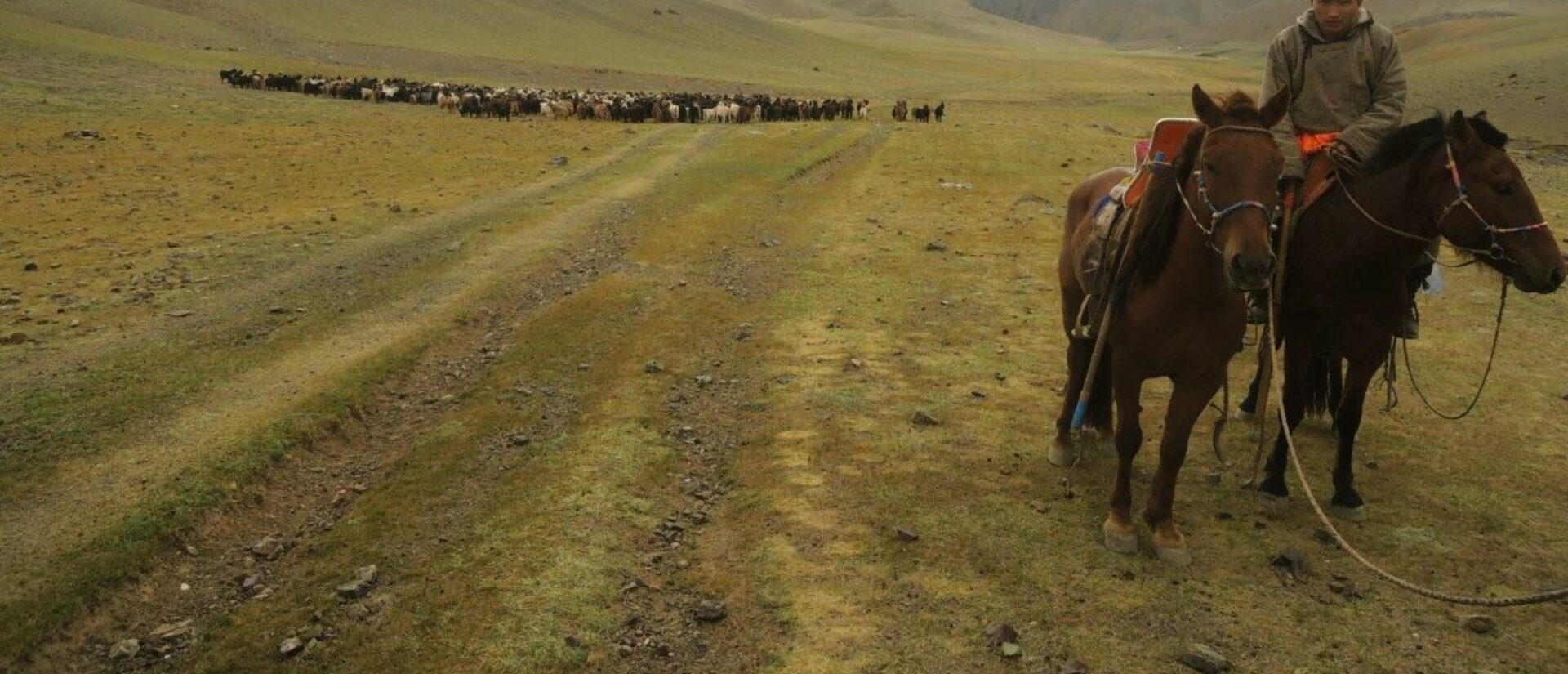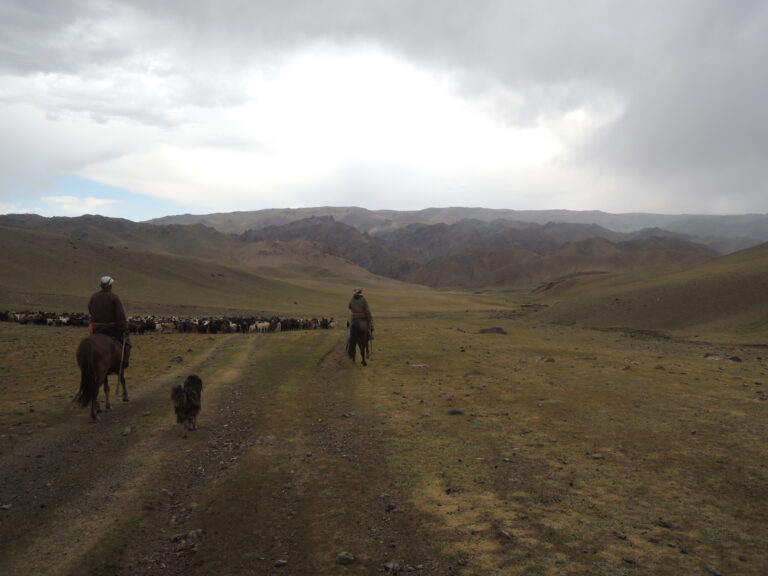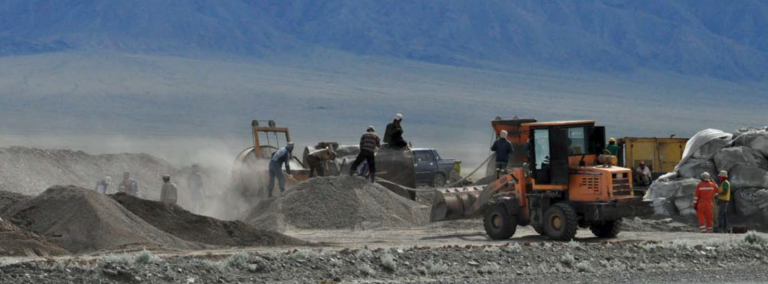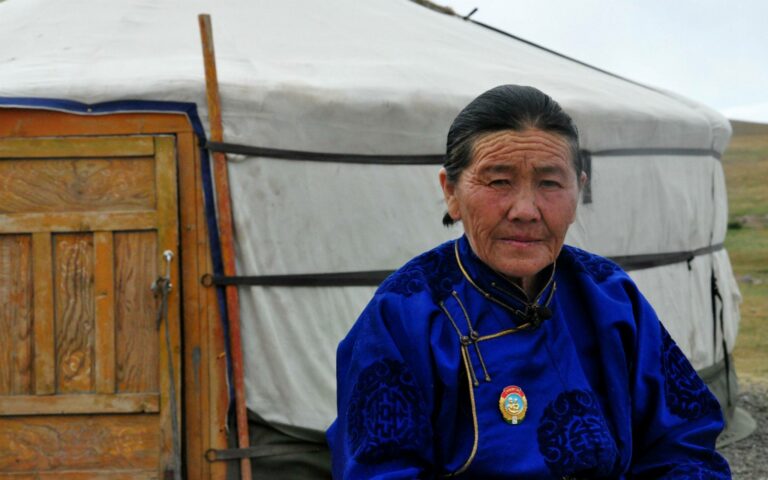
Mongolian herders bear the impacts of iron ore mine
Iron ore mining has pernicious effects on the nomadic inhabitants of the Govi Altai region in Mongolia. The European development bank that financed this mine should have known better, concludes the research organisation SOMO.
This article has been published in Dutch on the Oneworld (opens in new window) website.
The Mongolian steppes are empty; indeed, almost deserted. We are travelling from the capital Ulaanbaatar to Govi Altai to visit herders near the Tayan Nuur mine(opens in new window) , the second largest iron ore mine in Mongolia, owned by the Mongolian company Altain Khuder(opens in new window) . As we drive our car down that route, we seem to have reached the end of the world. This road is the only sign of human presence; the vegetation reaches little more than a couple centimeters in length. The only sign of life are the herds of goats, sheep, cows, horses and camels that forage around the area in small groups. This is hardly surprising; after all, Mongolia is the least densely populated country in the world, and half of their scant population lives in the capital city. If there is one place in the world where large-scale mining should have a low impact, this would be it.
The mine kicks up large amounts of dust, reducing the land’s fertility and damaging the health of humans and animals
But once we arrive at our destination, it soon becomes clear that there’s more to it than meets the eye. However empty the area might seem, not an inch of land goes unused. Local nomadic herders make intensive use of their land; they have distributed all the fertile areas so as to ensure enough food and shelter for their livestock. They move their herds around twice to four times a year to avoid overgrazing. Meanwhile, the mine kicks up large amounts of dust, reducing the land’s fertility and damaging the health of humans and animals alike. The road laid out by the mining company to facilitate export activities cuts through the herders’ pastures and migration routes.
Minegolia
Some years ago, Mongolia was nicknamed Minegolia. Large deposits of copper, gold, coal and iron ore were discovered, and the investment climate seemed perfect for foreign companies in search of quick profits. International institutions and development banks, including the European Bank for Reconstruction and Development (EBRD)(opens in new window) , were among the largest financiers of this mining boom. After a 2013 conflict (opens in new window) between the Mongolian government and the international mining company Rio Tinto (opens in new window) (Dutch article) about overspending and after the government reversed a large number of concessions, the interest dwindled just as rapidly. Hardly any foreign companies still dare to embark on new investments in Mongolia. But some institutions, such as the EBRD, continue to be involved in ongoing mining projects. One of these projects is the Tayan Nuur mine, which has been in operation since 2009. Owned by the Mongolian company Altain Khuder, the EBRD has purchased a minority stake in the company and has also granted it a loan for a sum well into the millions. SOMO, CEE Bankwatch(opens in new window) and the Mongolian human rights organisations OTWatch and Lawyers for Environment, have carried out joint research into the impact of this mine on the living conditions of nomadic herders in the area.
The dust clouds that land on the neighbouring grasslands are causing lung problems and other diseases among the cattle.
Negative impacts
The result of this research, which will be published in the coming months, begs the question: why would a European development bank invest in such a venture? Most of our findings point to developments that the EBRD and other stakeholders could easily have foreseen.
The company exports all its iron ore to steel factories in China. To keep transport costs low, the company is building a paved road between the mine and the border crossing point. In the meantime, as the new road is constructed while the old continues to be used, huge dust trails continue to rise, and dust landing on neighbouring grasslands causes lung problems and other diseases among the local herders’ cattle. These herders reported losing dozens of animals. Altain Khuder has carried out health checks on some of the cattle, but is refusing to publish the results. None of the herders has been awarded compensation. Getting the road built is an integral part of Altain Kuder’s business plan, and the EBRD should have taken its negative impacts into account.
Winter camps
Additionally, a few dozen herders were forced to move. Their winter camps, the only permanent structure used by these herders, were located at the site of the mining operations. Although international standards specify that a mining company must ensure at least equivalent living conditions for displaced communities, these herders have only been awarded a one-time cash compensation. Regardless of whether the amount was sufficient, one-off monetary payments are not appropriate compensation measures, given the fact that land in Mongolia cannot be purchased, but is allocated democratically by the herders themselves. We spoke to an older herder who was blocked from new land because she had accepted money from the mining company. She and her couple hundred heads of livestock now had to use the land of her relatives, where she was understandably met with a less than enthusiastic welcome.
Several herders and local politicians have complained to the company about these impacts and communicated their discontent openly. Instead of engaging these stakeholders, Altain Khuder responded by taking them to court. The company accused them of ’the aggrieved organized crime of defamation’, a charge that carries a 20-year prison sentence in Mongolia. The case has now been dismissed by several courts, but the company continues to push its legal battle. The herders and politicians who have been sued feel pressured and intimidated, but they are standing their ground.
Expected longevity
These developments can be explained by Altain Khuder’s business model. Driven by aggressive production targets, the mine itself will expand rapidly, as will its impact. At the same time, the operating lifespan of the mine is expected to be no more than ten years, reducing the incentive for the company to engage in meaningful stakeholder involvement. This again elicits several questions:
Why is the EBRD not taking any measures to guarantee that the company that it is financing operates in fulfillment of internationally accepted standards? Why doesn’t it take steps to guarantee the wellbeing of local herders, to establish an appropriate compensation mechanism, and to ensure that the company negotiates with its stakeholders in a way that is respectful and meaningful?
Do you need more information?
-

Joseph Wilde-Ramsing
Advocacy Director
Partners
Related content
-
 European Development Bank accepts complaint submitted by Mongolian herders about iron ore mining companyPosted in category:NewsPublished on:
European Development Bank accepts complaint submitted by Mongolian herders about iron ore mining companyPosted in category:NewsPublished on: -

-

-
Impacts of the global iron ore sector Published on:T. SteinwegPosted in category:PublicationT. Steinweg
-


